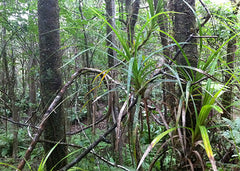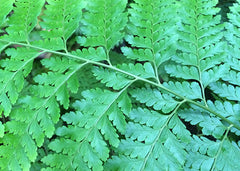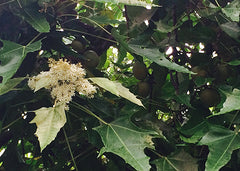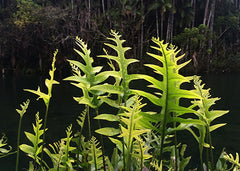Kinolau Hula

The practice of hula is unique to Hawaiʻi. The dance has beginnings when the gods dwelled amongst the land: the pantheons of spirits roamed the earth and giant lizards could turn themselves into handsome men or huge stones. Pele and Hiʻiaka is our initial glimpse of hula at Hāʻena on the island of Hawaiʻi. The dance was born when Hiʻiaka mimicked the movement of the sea and wind. Our most traditional dances began depicting movement and character of nature, illustrating the flowers and trees of the forest.
Through the Kumulipo, the Hawaiian Creation Chant, and Pele and Hiʻiaka, the literal account of protocol and ritual, we learn the hierarchy of the plants in Hawaiʻi and the role each one plays in our universe. Those writings, centuries old, are still relevant today as the seasons come and go, the moon cycles through its phases, and the tides continue to rise and fall.
The forest is an important part of hula. The ferns, trees, vines, leaves, and flowers are the embodiments of hula. As we gather each frond and leaf, we are taking the bodies of our deities. We honor and respect the greenery as we weave our lei and decorate our bodies. When we dance, we become the trees. We are the flowers. We are the ʻōlapa.
The cycle of the forest is important to our lives! Attracting the clouds out at sea, the rains fall when the warmth of the land meets the clouds. The ʻōhiʻa trees and the plants of the forest drink in the rain, mists and the moisture. As the water falls through the plants and onto the land, the streams and rivers flow. Flowing from the uplands, the cycle of the water continues... flowing out to sea and then rising again as a cloud.
It is this respect to the universe in which we live that we honor through chant and dance. We speak of the rank of the various trees and ferns because we acknowledge their role in the balance of nature. Specifically for the practices with our hula, we direct protocol and ritual to the importance of these few as they are the representations of the deities.
Ola nā akua o ka nāhelehele!

KINOLAU HULA : PLANT HIERARCHY AND DESCRIPTIONS


Indigenous to Hawai`i, the woody vine often grows alongside the ʻōhiʻa trees. Found at lower levels, sometimes at sea level, it likes damp and wet climates. The vines shape the trunk and branches of the ʻōhiʻa as it climbs to the top, creating curly, twisting trunks.
Growing in the lofty canopies and blooming iridescently, it is considered a symbol of royalty. The aerial roots make hīnaʻi hoʻomoe iʻa (fish baskets), hīnaʻi hoʻoluʻuluʻu (fish traps), and mahiole iʻe (aliʻi helmets). A clipping of vines, leaves or flowers are placed on the kuahu hula (hula altar).
In ceremony, the ʻieʻie is the first of all plants set on the kuahu, representing the highest rank within the forest.


The ʻōhiʻa is an endemic plant found on all of the main islands except Niʻihau and Kahoʻolawe. ʻŌhiʻa are found mainly at higher elevations, while occasionally growing along the coast and in lowland dry forests. They can be found from sea level all the way up to around 6,000 feet. One of the first trees to colonize new lava flows, they are very important to our water systems. Flowers, leaves, and bark gather mist and rain, delivering it to our aquifers.
Gathering is the main function of this tree. The new sprouts, liko, are chosen for lei for hula kahiko. Budding in many different colors - orange, plum, charcoal, chartreuse - is the metaphor of the perspective for hula. Sprouting, budding; a blossoming persona of the forest, the dancer becomes the tree in the uplands. Liko is the symbol of children or a new beginning.


Palapalai is an indigenous fern native to Hawaiʻi. Found on all the main islands in both damp and dry forests, they grow near sea level and upwards to about 5,000 foot elevation. The fronds are very soft and are usually light to medium green in color. Medium sized ferns grow to be about 2-3 feet tall. The individual blades and the midrib are usually very hairy.
Palapalai rank highly within the forest as it functions as keeper of the moisture and dampness in the understory. This bank of water insures that the roots of the trees in the canopy are constantly nourished.


Lacy and light green, palaʻā is found in many environments throughout the islands. Around the forests of Kīlauea Volcano, the fern grows in the shade of the ʻōhiʻa alongside the ʻōhelo berry and the ʻūlei. Amongst the grasses of the pasturelands or hanging from the pali where the winds blow strong, the fern can be found dancing at the lower elevations. Deep within the rainforest, youʻll find it with long fronds.
Palaʻā is one of the plants that begin to green the lava flows. The fern is one of the requirements in Hiʻiaka's work as a healer, as her pāʻū of palaʻa ferns was necessary to have in the revival of Lohiau's life. The palaʻā is mentioned often in the saga of Pele and Hiʻiaka. In the battle at Panaʻewa, the pāʻū helped Hiʻiaka traverse the forest of the great moʻo and destroy him.
Lei palaʻā is the symbol of revivification.


The koa lives between the 1,000 foot and 7,500 foot level, with trunks sometimes growing over a hundred feet tall. It is one of the tallest native trees in the forest, sought especially for its trunk in building canoes. It is endemic to Hawaiʻi, growing on the five main islands.
The sickle shaped phyllodes attract moisture which drips down to the understory. This management of water from tree tops down to its roots is its function in the greater forest. Its protective canopy is a symbiotic relationship with its forest community.


Living amongst 'ōhiʻa and koa, the ʻōlapa tree thrives in the damp, wet forest. Its light green leaves, dancing in the slightest breeze, have a unique smell. Names and species vary slightly from island to island; ʻōlapa on some, lapalapa on others. Endemic to Hawaiʻi, the trees are found on all islands except for Kahoʻolawe.
The leaves are opposite on the branches, dividing into three to five small leaflets. Shapes vary from oval or oblong; some species being wider than other species. Flowers are numerous on leaf axils. Fruits form after the flowers bloom. The leaflets, knotted together, make the lei hīpuʻu.
On the kuahu hula, the ʻōlapa is the sixth kinolau. Lei ʻōlapa represents the greater forest and the movements of the dancer.
--------------------
-


Endemic to Hawaiʻi, maile is found at sea level forests upwards to the 4,500 feet altitudes. Lower forests nurture the bushes, pushing out vines that climb to the top of the canopy. While they proliferate in the damp and wet forests, the plant survives in the medium dry forests with fern understory.
A very popular lei, the fragrant maile grows in various shapes and sizes, from very tiny narrow leaves to large dark oval. There are two, three, and sometimes four-leaf maile, specific to the area of growth.


The kukui is one of our canoe plants, brought to Hawaiʻi by earlier settlers. Its distinct leaf shape and light green color distinguishes this tree from a distance.
Growing at sea level upwards to 1,000 feet, the tree is most useful. Its English name, Candlenut Tree, describes its use: seeds strung on a coconut midrib is a candle. The nuts are used to create ʻinamona (relish) in many recipes. Resin and sap are important medicines. Dyes are obtained through seed, root, and bark.
Ranking eighth of the kinolau hula, lei of leaves and flowers are placed on the kuahu hula. The significance of kukui is enlightenment, as the word means light.


Known for its fragrance, the lauaʻe fern is included in many kinds of lei. Famous is the grove at Makana, Kauai, noted in song and chant. Growing profusely in shaded moist areas, the dark green fern makes up the understory at lower elevations, even growing near the ocean. Fronds rise up from runners, spreading quickly.
The fragrant leaves are often used to scent kapa. Placed within the folds, the aroma adds to the essence of the kapa.
Ranking ninth, the lauaʻe establishes the hierarchy of plants in the hālau hula. Lei lauaʻe is symbolic of the gathering together of Kumu and haumāna.

